“城市公共藝術家”劉恒甫
從小出生在美麗的冰雪之城
他用繪畫寫生著世界萬物
用鏡頭記錄著冰與雪的世界
用雕塑裝點城市文化
用設計連接未來

劉恒甫-城市公共藝術家
中國開發性金融促進會文旅委員會副主任、創意總監
中國藝術研究院名譽研究員
故宮研究院客座研究員
清華設計院文化旅游學院藝術總監
北京市優秀文化藝術人才
北京恒甫視界藝術總監
曾榮獲中國工藝美術大師金獎、中國旅游商品博覽會金獎首屆中國創意設計大賽金獎、2015年中國最佳主題公園獎
他曾經為了記錄冰花綻放的瞬間
瘋狂讓人用雪球砸他
才捕捉下這唯美的一景
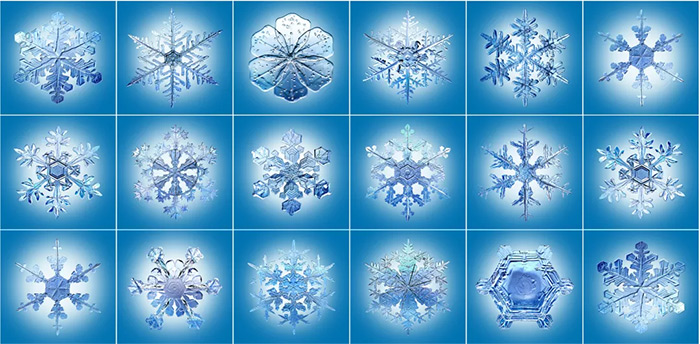
攝影-雪花清韻

攝影-窗花夢幻

攝影-冰彩神奇
擁有逾500臺相機,既是收藏品,也是創作工具。
攝影塑造了他個人的冰雪美學。
此外,他還繪畫、做雕塑、
建造了公益展館、設計了主題公園、
擁有自己的時尚品牌等,
并且多年來樂此不疲,
成為一個多維藝術家。

公共藝術-藝創嘉華
十月底
我們拜訪了劉恒甫老師的藝術館,
和他一起喝茶、聊天
探討“他的關于藝術那些事兒”。

劉恒甫北京工作室
劉恒甫老師的工作室坐落在北京宋莊,工作室緊依一個青翠寧靜的湖,湖邊矗立著一尊巨大的有如中國剪紙造型的紅色魚形藝術裝置,非常引人注目。
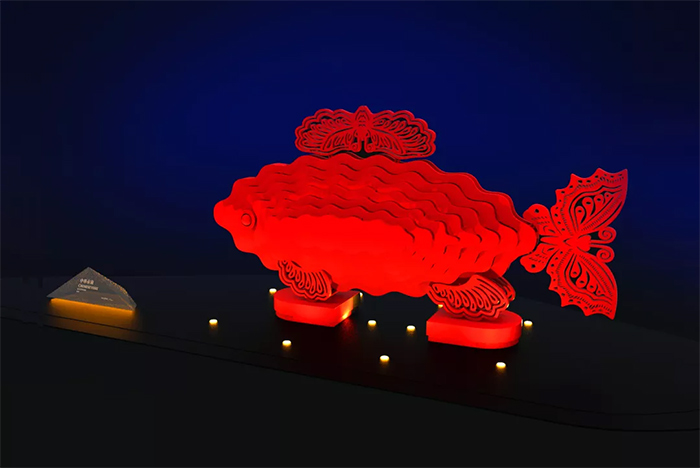
《中華有魚》國家南海博物館,長12米

劉恒甫:現在這個作品就是我的一個代表作叫《中華有魚》,這件作品它是用一個祥云彩蝶中國結,用中國的紅顏色表現中國的一種吉祥,一種幸福,它是用什么呢,用手工做出工業標準,就相當于用手工去制造個汽車一樣,純手工做的,這條魚也是用了我代表性的創作語言。

雕塑《春風》
劉恒甫:這件作品的名字叫《春風》,它是用這個面和重復的線條構成的空間體量,你看它在人在動的時候,隨著各種角度的變化,它在產生各種細微的切換。
秦紅:每一個角度的畫面都不同。

工作室內展示了他各時期的作品
劉恒甫:這個展示空間展示著我不同時期的創作作品,上面階段是“心象無極"系列,這邊是“禪”的系列,包括剛才看的雕塑。

油畫-環宇冰心(2010)
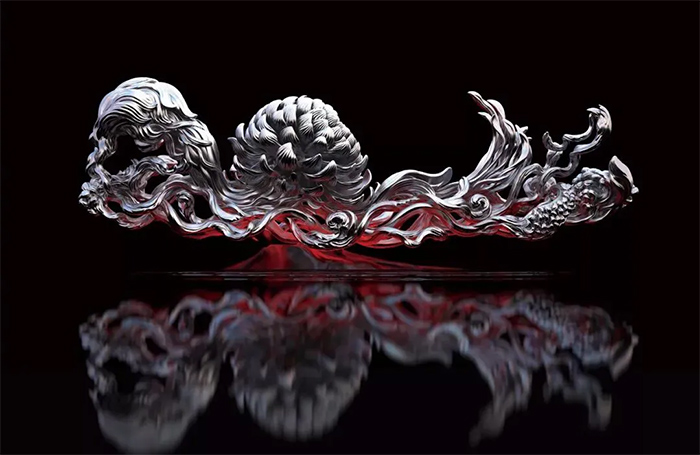
蓮?心,120x360cm,不銹鋼圓雕,2014
秦紅:您出生在美麗的北方冰城,這對于您用這種千姿百態晶瑩剔透的冰花作為藝術元素進行創作,有什么直接的影響?
劉恒甫:當然有影響,而且影響非常深遠。因為北方作為一個寒冷洪荒、浩淼這么一個自然的世界,它不僅塑造了人的性格,同時這種自然的生態它也給人千萬聯想和遐想,這樣就產生了冰雪的晶瑩和剔透、林海雪原這種洪荒蒼茫。
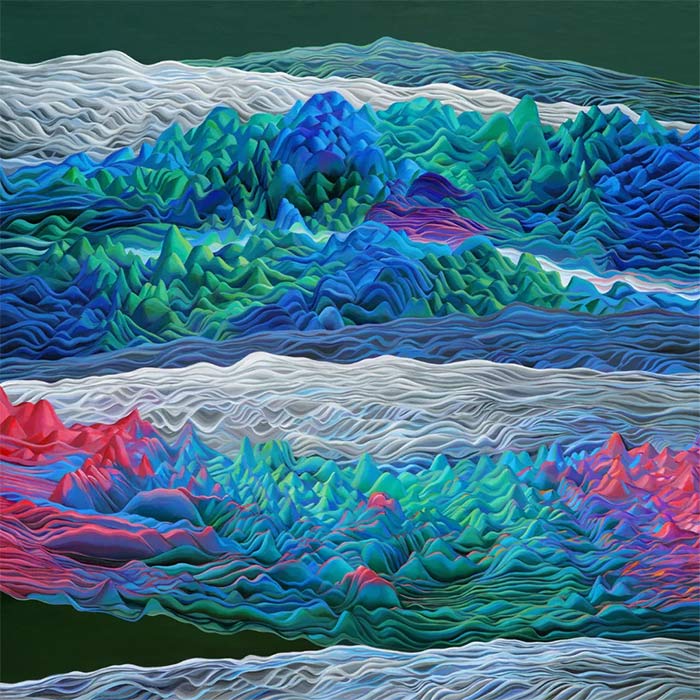
布面油畫-春山雪霽
縱觀我的藝術創作,還是這種叫質樸雄渾、簡約博大,關鍵就是在解讀和表現宇宙、山川、自然、大的這種廣闊的意境和境界,這就是山水、天地、人文之間的關系。

江山圣境,240x240cm,布面油畫,2010
其實我的整個藝術創作呢有幾個階段的跨越,第一個階段應該叫看山是山,看水是水。這個階段是屬于學習階段,屬于藝術在入門,在前期積累學習的階段,這個期間對自然、萬物、包括各種題材的理解,表現和表象,它是基于對自然原生態的一種苗頭。

心象無極,80x240cm,布面油畫,2007
第二個階段就是說看山不是山,看水不是水,就是講主觀的內容了。比如說我看到山川,我看到林海,我想到的是生命的燃燒、是一個偉大的圖騰。這時候達到一個藝術創生、創造的這么一個境界,就是強調主觀表現,最高的境界就是看山還是山,看水還是水,這個是最難的。就把一切表現浮躁的浮夸的東西,把它洗掉,一切直達主題。
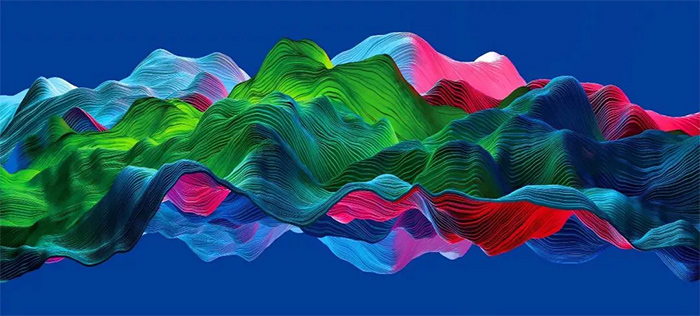
絲路祥音,150x340cm,布面油畫,2015
為什么我朋友講你的繪畫,有大師味道,就是不用去想那么多,這種就是尼采講叫什么呢、叫人生三個境界不也是嗎?
最后歸屬于嬰兒這種天真、浪漫、無我、自然的狀態,這是在咱們中國來講就叫天人合一。

布面油畫-心象無極(2009)
秦紅:您的藝術創作涉及了繪畫、攝影、雕塑、平面設計、城市的景觀設計、建造很多的方面,您是一位名副其實的跨界藝術家,那么您是怎樣理解多維藝術家這個概念?
劉恒甫:其實多維很簡單,世界是多維的,人生多維的。還有一個是什么?上帝給咱們裝這套硬件感知系統多維的,分聽覺、視覺、味覺、觸覺,所以說這樣的話就是人本身就很立體,從藝術創作上我認為也很簡單,你想做啥做啥,要想做二維的,我就把二維叫做圖形,三維叫做立體造型,當然還有四維,別局限于什么一個畫種,一個畫派一個雕塑的手段,千萬別受這些羈絆,不要受這些拘泥和這些形式的拘泥。所以說不能受各所謂的專業的拘泥,想干啥干啥。

木雕-梅蘭竹菊(2016)
秦紅:這中間有一個從二維平面到多維立體的思維轉化,您是怎樣完成轉化過程的?
劉恒甫:一是隨意行走,二我是來自基層,我所要做的事我要完成目的,我要用各種手段來表現,這就不拘泥這種技巧技法,該用的筆的筆,該用刀的刀,該直接領著人,拉一堆電焊機可以直接焊了是吧?

公共藝術-金風浩蕩
我的有些作品很大,我曾經做過一條50米長的魚,每一個構件都用吊車的。
秦紅:50米長的魚,難以想象。
秦紅:現在在哪里放著?
劉恒甫:在松花江邊。

公共藝術-冰源圣景
秦紅:您用雕塑、繪畫與設計等多種介質詮釋著東方的文化精神,那么您認為傳統的文化藝術在未來是一個怎樣的發展態勢?
劉恒甫:我們一直在說的一個觀點叫民族的是世界的,錯,我在認為民族的永遠是民族的,世界的它才是世界的。作為當今整個世界的文化思潮,包括審美風尚,它是有一個時代特色的,首先要用人性化的語言,鮮明的符號來感動所有的人,這種才是最高級的作品。不要刻意的強調民族時代技巧。
這些都是手段,最重要的是表達出想表達的內容,表達什么很重要。

雕塑-綠水青山 千里江山
作為藝術,雖然沒有民族,但是有東西方。東西方上到最高層是哲學和宗教,它們之間產生差異,所以說這個時代,無論是中國的畫家、藝術家,或者東方的藝術家想贏得全世界的掌聲或者尊重的話,他要用國際化的語言,國際化的手法,最后表現東方的文化精神。
說到精神它是個實質東西,精神是什么?東方化精神的是老子莊子一種神秘形之上的悠遠意境。
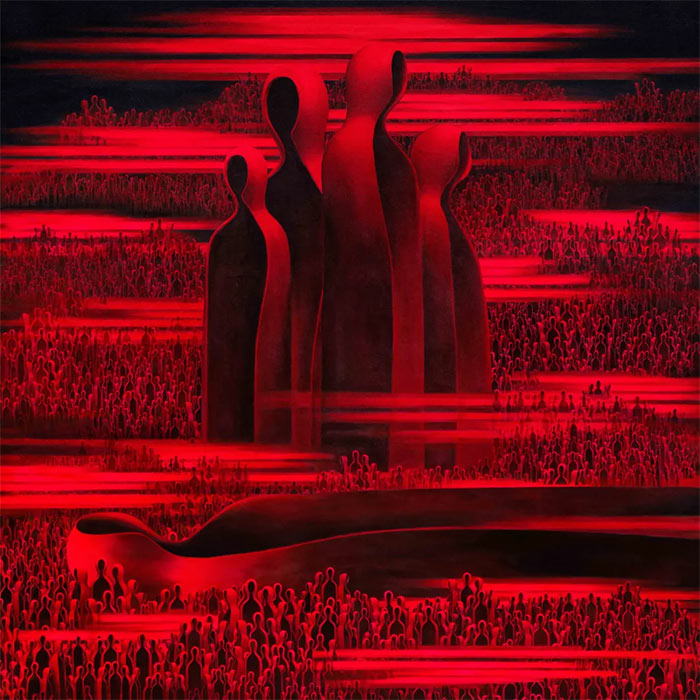
油畫-《元》系列(2015)
秦紅:正想問您,您作品中的這種東方意蘊要表達的是不是就是您說的這些。
劉恒甫:東方意蘊、東方情韻、東方的這種哲學,甚至說宗教的最高境界,這個不僅是從繪畫上,從任何藝術門類最高境界都是叫禪心、文心、菩提心,達到這個境界。無論是繪畫、雕塑、音樂、舞蹈、書法,所有的最高的境界都是達到什么呢?像剛才咱講的叫最高境界叫不食人間煙火氣,那種空明、寂靜、悠遠,這是咱們東方文化的最高境界,就是禪境。
秦紅:那么想問一下哪一幅作品是您自己最滿意的代表作,比如說是不是我們身后的這幅《心象無極》。

心象無極No.003,109x327cm,布面油畫,2007
劉恒甫:這幅作品它把山川、宇宙、心象、神靈匯集到一個畫面上,你看它不是山,但是有山的巍峨;它不是海,但是有海的廣博,一束金光從天外打來,金光普照天地吉祥。
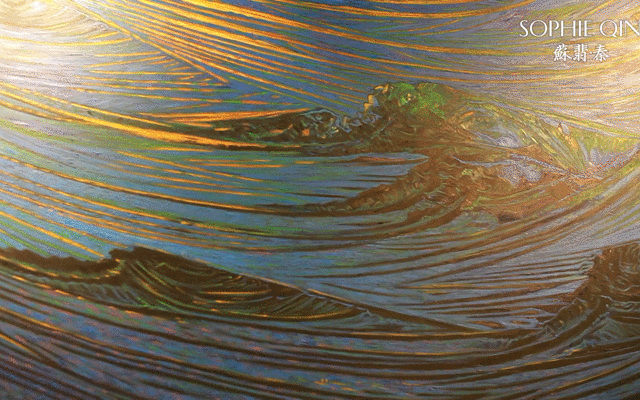
這幅作品也是代表我的東西方繪畫融合的一個最高境界。因為剛才講到,東西方它不是靠地理來界定,因為地球是圓的,誰承認誰東誰西,但是從宗教上叫耶穌,他管它叫西方,像釋迦摩尼、穆罕默德,信這個宗教叫東方。
這件作品是從神學層面跨了東西方,全世界不同民族、不同信仰、不同國界的人都能找到自身的信仰,從文化的層面,從哲學的層面真正跨越了東西方。
秦紅:您的冰雪系列的藝術作品,今年剛剛在故宮展出,您是怎樣看待藝術與冬奧以及體育的結合?
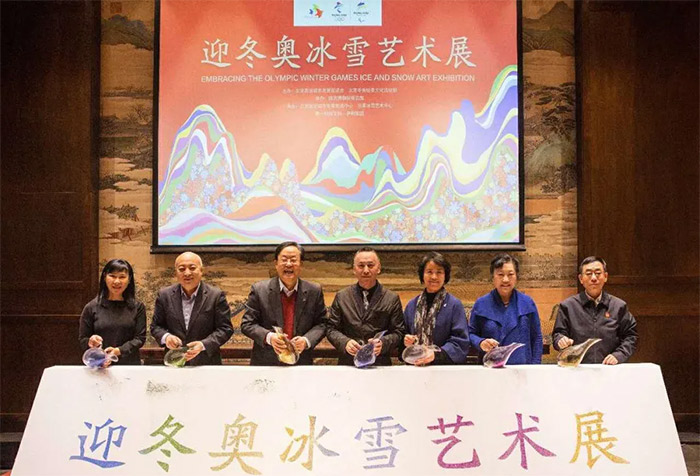
揭幕嘉賓:葉喬波、王旭東、劉靜民、劉恒甫、韓子榮、趙少華、張建星(左起)
劉恒甫:體育文化都是生活的部分,它們應該先天的就是一個不可分割的結合。你比如包括古希臘一些競技,包括現在的體操,它都是人運動至美的形態一個表現,所以它本身就是藝術。
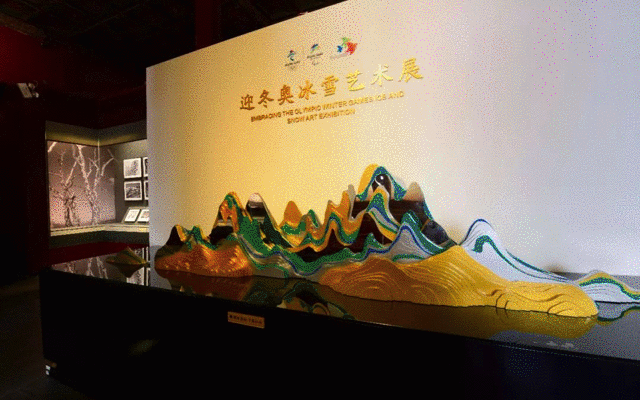
所以冰雪和冬奧,它倆又是一個不可分的關系。因為冬奧兩個字兒,一個是冬,一個是奧,奧就是奧林匹克,冬代表季節。當然也就區分了咱們體育競技項目的種類,所以說我們北京雖然是自然冰雪,差強人意,但是我們如果有最高層次世界最頂級的冰雪藝術來點綴襯托,這個時候一樣能贏得全世界的喝彩。所以說我認為一個冰雪藝術至少在北京冬奧能為國爭光,為冬奧添彩。

《中華之夢》北京冬奧主題雕塑,高12米
國際奧委會主席|托馬斯?巴赫
為藝術家劉恒甫展覽致序
“迎冬奧冰雪藝術展”
北京是一座歷史悠久之城,也是一座創造歷史之城。作為2022年冬奧會的主辦城市,北京將再次創造歷史,成為世界上首座既舉辦夏季奧運會又舉辦冬季奧運會的城市。北京2022年冬奧會將首次在中國展現奧運冰雪運動的神奇魅力。
本畫冊收錄了迎冬奧冰雪藝術展的精彩圖集,邀請讀者透過中國藝術表現的鏡頭發現冬季運動的魅力。此畫冊是奧林匹克主義始終與運動和文化相互交融的美麗例證,也是國際奧委會創始人與奧運會復興者顧拜旦的基本理念。
作為中國首次在標志性的故宮博物院舉辦的此類展覽,是宣傳北京2022年冬奧會和鼓勵公眾參與冬季運動的重要一步。這也是我希望向本次展覽的組織方——北京冬奧組委、北京奧運城市發展促進會和故宮博物院表示祝賀的原因。
北京2022年冬奧會所體現的冬季運動魅力和奧林匹克價值觀將激勵新一代人。北京將在2022年迎接全球最優秀的運動員,再次創造奧運歷史,而本次展覽這樣的文化亮點為此奠定了基礎。
托馬斯·巴赫
國際奧委會主席
秦紅:作為著名的冰雪藝術家,您是怎樣一直保持著自己的創作激情?靈感都來自哪里?
劉恒甫:我的靈感首先還是對自然的熱愛,因為人嘛,我對山川、對自然的萬物,那種崇尚那種至美這種追求,有句話叫知之者不如好之者,好之者不如樂之者,我很榮幸我是樂之者,所以說我對自然的親近,對藝術的追求是我的快樂。
秦紅:恒甫老師有一個surprise給您,因為今天要對您做采訪,昨天晚上我給您畫了一張肖像。
劉恒甫:太精彩了,大師風范,神似。
秦紅:后面的這個圖像是您的一個景觀設計,在哪里呢?
劉恒甫:是有一個景觀雕塑,這個是26米高,在八達嶺高速在這矗立,應該說咱們目前中國迎冬奧最大一件作品。
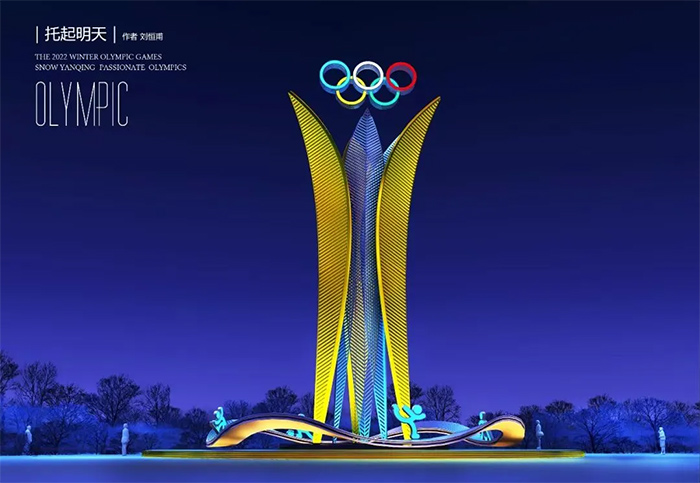
《托起明天》北京冬奧主題雕塑,高26米
劉恒甫:謝謝秦紅老師,這畫畫的太精彩了,神似,特別喜歡。
秦紅:我覺得這一次我也是有幸的去欣賞參觀了恒甫老師在故宮的畫展,希望不久的將來可以在凡爾賽宮或者是盧浮宮看到您新的展覽。
劉恒甫:好 ,謝謝。
責編:Echo
Transboundary Unbounded
Liu Hengfu’s Multidimensional Art World
Sophie Qin:Today we have come to visit teacher Liu Hengfu's studio. Let’s enter his world of art.
Liu Heng Fu: Mrs. Qin Hong
Sophie Qin:Hello, Teacher Heng Fu, Teacher Heng Ni.
Liu Heng Fu:Come in, come in, welcome, warm welcome!
Sophie Qin:Thank you.
Teacher Heng Ni:I will prepare some tea for you.
Sophie Qin:Thank you.
Spring Breeze
Liu Heng Fu:The name of this work is Spring Breeze. It has depth of volume formed by this surface and repeated lines. You can see that when you move, the dimensions change and produce various subtle switches in angle. Then every angle of the picture is different depending on the perspective.
ZhongHua You Yu
Liu Heng Fu: Now this work is one of my pieces called Zhonghua You Yu. This piece uses the auspicious butterfly Chinese knot. The red color represents China's auspiciousness and contentment.
How was it made? By hand. Creating this by hand to industry standard is equivalent to making a car by hand. This fish also uses my signature creative style of language.
Let's take a look at my art gallery.
Sophie Qin: Great.
Exhibition Space
Liu Heng Fu: This exhibition space displays my different creative periods. Over there is the Psychic Promise collection. This is the Zen series, which includes the sculpture you just saw.
XinXiang WuJi
Liu Heng Fu:This work is called Xinxiang Wuji. It brings mountains, rivers, the universe, the heart, gods and spirits together onto canvas. You see it's not a mountain, but there is the impression of a mountain. You see it's not the sea, but it conveys the vastness of the sea. A beam of golden light hits from above, shining golden light across the world
Sophie Qin:It's really Zen, very artistic.
Sophie Qin: Let’s talk more about this topic. You were born in a beautiful northern Chinese city of ice and snow. What direct influence does this have on your creations?
Liu Heng Fu:Of course, it has an impact, and the impact is very far-reaching. Because the north is a cold, wild, vast and natural, it not only shapes people’s character, but this natural environment also gives a person many associations and memories, which manifests as ice and snow, the sea, the vast and wild snow fields.
Throughout my creations there is this kind of simple, majestic broadness. The key is to interpret and express a vast artistic concept combining the realm of the universe and nature. This is the relationship between the landscape, the world, and the humanities.
My pieces all have several stages of artistic creation. The first stage is watching the mountains as mountains and watching the water as water. This stage belongs to the learning stage. It belongs to the art of beginning and accumulation. During this period the understanding, performance and appearance of nature is based on the natural ecological form.
The second stage is subjective. This means looking at mountains not as mountains, and looking at water not as water. For example, if I see mountains and rivers, I actually see immense seas and trees, I think of the burning of life. This point of creation emphasizes the subjective interpretation. This is the most challenging. Just wash away everything that is impetuous and exaggerated, and everything goes straight to the subject.
Why does my friend talk about your paintings? He said that there is a taste of a master, so you don't have to think about it so much? This is to say what Nietzsche called, called the three realms of life. In the end, it belongs to the innocent, romantic, selfless, and natural state of innocence. This is called the unity of nature and man in Chinese philosophy.
Multi-Dimensional Art
Sophie Qin:Your artistic creation involves many aspects of painting, photography, sculpture, graphic design, urban landscape design and construction. You are a real cross-disciplinary artist. How do you understand the idea of the multidimensional artist?
Liu Heng Fu:In fact, multidimensionality is very simple. The world is multidimensional and life is multi-dimensional.
What is the other one? God installed this perceptive system to interpret multi-dimensionally, you can see it divided into the senses of hearing, vision, taste, and touch. People are themselves very multidimensional. Creatively, I think it is very simple. What do you want to do? If you want to create two-dimensional graphics, three-dimensional modeling, of course, there are four-dimensions, so there is no need to be limited to painting, or a sculpture. You must not be limited in this way.
Don't be subject to these constraints and these forms of constraints. Therefore, you cannot be limited to learning of professional virtues alone.
Sophie Qin:There is a thinking transformation from two-dimensional planes into the three-dimensional. How do you complete the transformation process?
Liu Heng Fu:This is that one is walking willfully and I 'm comes from the grassroots.
What I want to do is to accomplish my goal, and I have to use various means to express it. This is not limited to one kind of technique, right? The paintbrush and knife that should be used should be led directly by the person, or it can be directly electric welded, right?
My work is very big. I’ve made a 50-meter-long fish and every component was moved by a crane.
Sophie Qin: 50 meters long fish.
Liu Heng Fu:Moved by car.
Sophie Qin:Where is it now?
Liu Heng Fu:On the Songhua River.
Future Direction of Traditional Cultural Art
Sophie Qin: You use sculptures, paintings, design and other media to interpret the cultural spirit of the East. What do you think is the future development trend of traditional culture and art?
Liu Heng Fu: We have been talking about a point of view that the nation belongs to the world. It is wrong. I think that the nation always belongs to the nation and the world belongs to the world.
As a cultural trend in the entire world today, including aesthetic trends, it has a characteristic of the times. First of all, it must use humanized language and distinctive symbols to touch all people. This is the highest-level of work. Don't deliberately emphasize aspects of the Age of Nations.
Sophie Qin:These are all means. The most important thing is to express what you want to express.
Liu Heng Fu:What is important.
As an art, although there is no nation, one still has East and West. The highest level in the East and the West is philosophy and religion. There are differences between them. So, if we say that in this era, whether it is a Chinese painter, a Chinese artist, or an Eastern artist who wants to win the praise or respect of the world, he uses international, humanized language and international techniques to finally express the spirit of Eastern culture.
Speaking of spirit, in substance what is spirit? The spirit of Lao Zi and Zhuang Zi has a mystery and form beyond artistic conception.
Sophie Qin: I just want to ask you whether this oriental connotation in your work is conveyed in this way.
Liu Heng Fu: Eastern connotation, Eastern sentiment, Eastern philosophy, and even the highest states of religion. This is not only in terms of painting, but the highest state of any art category is called Zen, Wenxin, and Bodhicitta, right? Reach this state. Whether it is painting, sculpture, music, dance, calligraphy, what are the highest realms reached? As we just said, the highest realm is that kind of reflective emptiness, silence, and remoteness. This is the highest realm of our Eastern culture, the Zen realm.
Favorite Masterpiece
Sophie Qin: Which work is your most satisfactory masterpiece. Is it the image behind (XinXiang WuJi) us?
Liu Heng Fu: Yes. This work really represents the most sophisticated integration of my Eastern and Western paintings. As I just mentioned, East and West are not defined by geography, because the earth is round, but rather depends on the perspective often told through the major religions.
This work transcends the East and the West from the theological level. People from different nations, different beliefs, and different national borders all over the world can find their own beliefs. From the cultural level, from the philosophical level, it truly transcends East and West.
Beijing Winter Olympics
Sophie Qin: Your ice and snow series of art works were just exhibited in the Forbidden City this year. What do you think about the combination of art and the Winter Olympics?
Liu Heng Fu: Sports culture is a part of life and should be inseparable from nature. For example, you include some ancient Greek athletes and include current gymnasts. They are a manifestation of the most beautiful form of natural human movement, so it is art in itself.
Therefore, ice and snow and the Winter Olympics are inseparable from each other. Because there are two words for the Winter Olympics, one is winter, and the other is the Summer Olympics. Winter represents the season. Of course, it also distinguishes the types of our sports. Although Beijing has natural ice and snow, it is not to one’s satisfaction, but if we have the highest level of the world's top ice and snow art to embellish it, this is truly praiseworthy.
Sophie Qin:It can transform disadvantages into advantages.
Liu Heng Fu:Yes, so I think an ice and snow art can at least win praise for the country and add luster to the Winter Olympics in Beijing.
Creative Passion
Sophie Qin:As a famous ice and snow artist, how do you keep your creative passion? Where does the inspiration come from?
Liu Heng Fu: My inspiration is first of all my love of nature, my love for mountains and all things in nature.
There is a saying that the one who understands something is not as good as the person who is skilled at it, and the skilled are not as good as those who enjoy it. I am honored that I am a person who enjoys. Being close to nature and pursuing art are the source of my enjoyment.
Sophie Qin:Teacher Heng Fu I have a surprise for you. Because I interviewed you today, I drew a portrait of you last night.
Liu Heng Fu:Fantastic!
Sophie Qin:Sorry.
Liu Heng Fu:Masterful.
Sophie Qin: Does it look like you?
Liu Heng Fu:A remarkable resemblance. Wonderful.
Sophie Qin: I feel like it has a resemblance. There is a landscape design of yours in the background. Where is this now?
Liu Heng Fu:It is a landscape sculpture, which is 26 meters high. It stands along the Badaling Expressway. It should be said that we are currently the largest work in China for welcoming the Winter Olympics.
Thank you, Mrs. Qin Hong. Your painting is so wonderful. I especially like it.
Sophie Qin:I feel fortunate to visit your exhibition in the Forbidden City. I hope to see your new exhibition in Versailles or the Louvre in the near future.
Liu Heng Fu:Thank you.




